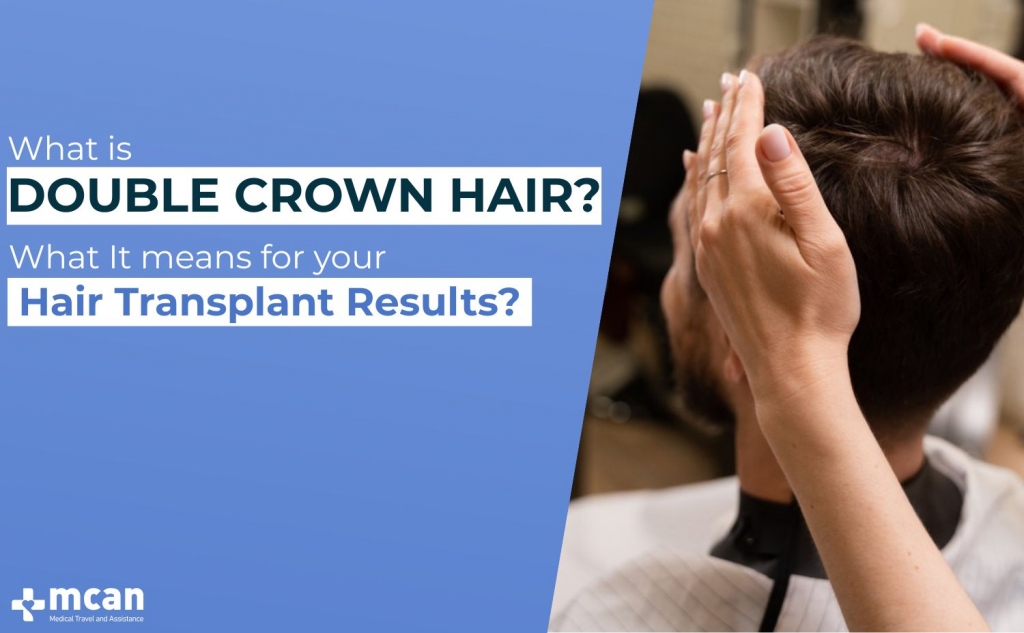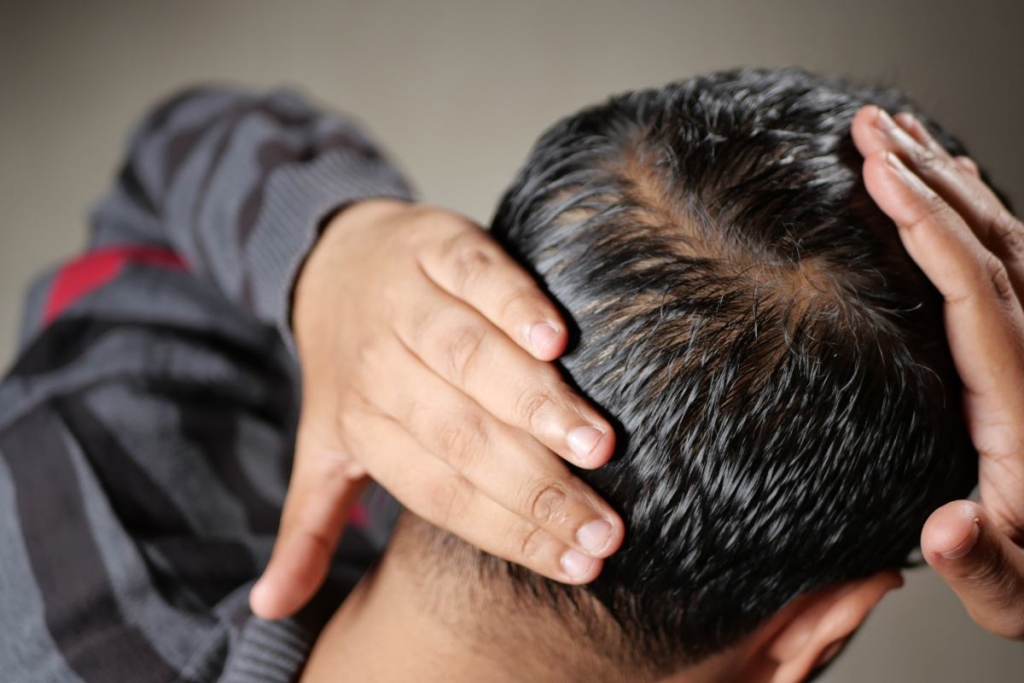
Every person’s hair grows in patterns unique to them, shaped by the way follicles emerge from the scalp. At the crown, the circular area at the back of the head, these growth patterns typically form a whorl or spiral. For most people, this means a single, centered swirl of hair. But for some, the crown contains not one, but two distinct whorls. This is known as double crown hair.
A double crown is a completely natural genetic trait, not a medical problem. Still, it often raises questions: Does it mean I’ll go bald? Will it make styling difficult? And most importantly for those considering surgery; how does it affect the outcome of a hair transplant?
Understanding double crown hair is particularly important in the field of hair restoration because the crown is already one of the most challenging regions to treat surgically. When a double crown is present, surgeons must take special care to recreate the natural spiral flow of the hair to achieve undetectable, long-lasting results.
This article will explain what double crown hair is, why it occurs, how to distinguish it from balding, and what it means for your hair transplant results. By the end, you’ll have a clearer picture of how this unique trait impacts both everyday styling and advanced treatments like transplantation.
What is Double Crown Hair?
A double crown occurs when two distinct hair whorls form in the crown region of the scalp instead of one. Each whorl creates its own spiral growth pattern, and together they can make the crown look like it has two overlapping swirls of hair.
For some, the two whorls are close together and blend almost seamlessly. For others, they are further apart, creating a more noticeable separation or line in the middle of the crown.
The key indicators of double crown hair are:
- Distinct whorls: Two separate spiral patterns are visible in the crown area.
- Unique flow: Hair may appear to grow in different directions, sometimes causing a natural “parting” or ridge.
- Genetic trait: The double crown is inherited and not a condition or abnormality.
- Stable over time: Unlike thinning or balding, the double crown itself doesn’t spread or progress.
Why Do Some People Have a Double Crown?
The presence of a double crown is simply a genetic trait determined by how hair follicles are programmed during early development. Just as genetics influence hair texture, curl, or density, they also shape the crown’s whorl pattern.
Some key points about why double crowns occur:
- Inherited pattern: If one or both parents have a double crown, there’s a higher chance their children will as well.
- Early formation: The crown pattern is established in childhood and remains constant throughout life.
- Completely normal: While unusual compared to a single crown, a double crown is not rare and does not affect scalp health.
- No direct link to baldness: Having a double crown does not mean you are more or less likely to experience hair loss since it simply alters how hair grows in the crown area.
However, because the hair naturally grows in different directions in a double crown, it can make early signs of thinning or balding more noticeable. This is particularly important since the crown is often one of the first areas affected by androgenetic alopecia, as explained in Crown Hair Transplant: Causes of Balding Crown and Treatment Options.
How Can a Double Crown Affect Hair Appearance?
A double crown isn’t a problem on its own, but because hair grows in two distinct spirals, it can create visual effects that some people find challenging.

Here’s how it can influence appearance in everyday life:
- Natural gaps or “split look”: Hair may separate along the whorls, making it look like there’s a thin patch, even when density is normal. For example, some people notice a line or gap in photos, especially under bright lighting.
- Messy or uneven styling: Double crowns often resist flat or slicked-back hairstyles. Even with gel or spray, the hair may appear to stick up or swirl differently on each side.
- Early signs of thinning appear exaggerated: When hair loss begins, the double spiral can make it look worse than it is. For instance, men in their 20s with mild thinning often say their crown looks “bald” in pictures, though a closer exam shows plenty of hair left.
- Harder to conceal hair loss: Unlike a straight hairline recession that can be styled around, crown thinning, especially with a double crown, can be harder to disguise because of the way light reflects on the scalp.
Double Crown vs. Balding Crown: How to Tell the Difference
At first glance, a double crown can resemble early signs of balding, especially when light reflects on the scalp and creates the illusion of thinning. But there are clear differences between a naturally occurring double crown and genuine hair loss in the crown area.
The table below highlights the main distinctions:
| Feature | Double Crown | Balding Crown |
|---|---|---|
| Cause | Genetic trait, stable from childhood | Androgenetic alopecia (pattern hair loss) |
| Hair Density | Normal density; hair remains thick | Gradual thinning and miniaturization |
| Pattern | Two spiral whorls, symmetrical | Expanding circular patch, uneven |
| Scalp Visibility | Scalp may appear under bright light due to swirl pattern | Increasing visibility even in normal light |
| Progression | Stable throughout life, no expansion | Worsens over months or years without treatment |
| Self-Check | Looks the same in old and recent photos | Noticeable widening of thin area over time |
Self-Assessment Tip: Compare old photos with your current hair. If the pattern looks the same, you likely have a natural double crown. If you notice widening gaps or progressive thinning, it’s a sign of early crown balding.
Why the Crown Area is Challenging in Hair Transplants
The crown (or vertex) is one of the most technically intricate zones in hair restoration. Unlike the hairline, which follows a relatively predictable pattern, the crown’s spiral design requires a combination of medical precision and artistic sensitivity. Mistakes here can easily result in results that look patchy, unnatural, or fail to age well.

The Spiral Growth Pattern
Every crown has a whorl pattern; a spiral where the hair radiates outwards, clockwise or counterclockwise, from a central point. In some patients, especially those with a double crown, there may even be two intersecting spirals. This makes it far more complex than simply placing grafts in neat rows. To achieve natural results, surgeons must carefully replicate this growth pattern, adjusting the angle of each follicle with almost microscopic precision. If the spiral is not reconstructed correctly, the crown can look flat, artificial, or mismatched compared to the surrounding hair.
Angle and Direction Precision
The crown is unique in that hair angles vary dramatically within just a few millimeters. Follicles may point forwards, sideways, or backwards depending on where they sit in the swirl. This means the surgeon cannot simply apply a “uniform” placement technique. Each graft must be angled and oriented differently, following the whorl’s natural geometry. Achieving this requires experience and a steady hand, as even small errors can lead to hairs growing in conflicting directions which is a sign of a poorly executed crown transplant.
Density and Coverage Demands
The crown covers a large circular surface area, and hair naturally lies flatter here than at the front of the scalp. Because of this, creating the illusion of fullness in the crown requires more grafts than a frontal or mid-scalp restoration. For example, while a patient may need 1,500 grafts to rebuild a hairline, the crown might demand 2,500–3,000 just to achieve similar visual density. For patients with limited donor supply, this creates a challenge: should grafts be prioritized for the crown, which is often less visible in daily interactions, or for the hairline, which defines facial framing? Strategic allocation becomes essential.
This kind of forward-looking planning is crucial to avoid exhausting donor reserves too early, as highlighted in Hair Transplant Donor Area: Why It’s Critical for Natural and Lasting Results.
Long-Term Considerations
Another complexity is that crown hair loss often continues to progress well into a patient’s 40s and 50s, sometimes more aggressively than at the hairline. If too many grafts are placed in the crown during an early procedure, it may leave little donor hair available for future surgeries. Skilled surgeons plan crown restoration with this progression in mind, often opting for moderate density that looks natural now but still leaves options open for future treatment. This forward-thinking approach ensures that patients avoid the “island of hair” effect, where transplanted follicles remain in the middle of a bald crown surrounded by further thinning.
Double Crown Hair and Its Impact on Hair Transplant Results
A double crown presents unique challenges during a hair transplant. Unlike a single whorl, surgeons must work with two spirals, each with its own growth direction. To achieve natural results, precision and experience are essential. Here’s how it affects the outcome:
- Planning: Surgeons must map out both whorls, ensuring the spirals blend naturally instead of clashing. Without careful planning, hairs can point in the wrong direction.
- Graft Distribution: More grafts are usually required since two spirals cover a larger area. Equal distribution prevents one whorl from looking denser than the other.
- Angle and Direction: Every graft must follow the natural swirl of each crown. Even slight errors can cause hair to stick out or grow unnaturally.
- Risk of Unnatural Results: Poorly designed double crowns may look stiff or asymmetrical, making the transplant noticeable rather than seamless. Avoiding these mistakes requires not only technical skill but also a deep understanding of the elements that define success, as outlined in Hair Transplant Success: The Key Elements Behind a Great Result.
- Aesthetic Balance: The crown sets the backdrop for the entire scalp. A natural double crown enhances harmony, while mistakes here can undermine an otherwise perfect hairline. Patients can also review the typical recovery stages to better understand what to expect after crown surgery, as shown in Hair Transplant Timeline: A Guide to Hair Transplant Recovery & Growth Chart.
Hair Transplant in Turkey for Double Crown Cases with MCAN Health
A successful crown restoration depends on more than just graft numbers. It is about replicating the complex spiral patterns of your natural hair. For patients with a double crown, this challenge is even greater. That’s why choosing a clinic with proven expertise is essential.
At MCAN Health, we specialize in advanced cases like double crowns, where artistry and precision make all the difference. Our internationally accredited team approaches every crown surgery with detailed mapping, careful graft distribution, and a commitment to natural, lasting results.
When you choose MCAN Health for your hair transplant in Turkey, you benefit from:
- Expertise in complex crowns: Surgeons experienced in designing and replicating double whorl patterns.
- Advanced techniques: FUE, Sapphire FUE, and DHI for precise graft placement and faster healing.
- Patient-focused care: All-inclusive packages with transfers, accommodation, and 24/7 support.
- Long-term strategy: Preservation of donor area and planning for future needs if hair loss progresses.
At MCAN Health, your double crown is an opportunity to create results that look completely natural and age gracefully. With our focus on detail, technology, and patient care, you can trust your crown restoration is in the right hands.
 Hair Transplant Gone Wrong: Signs of Bad Hair Transplant
Hair Transplant Gone Wrong: Signs of Bad Hair Transplant  Hair Transplant Graft Counts: How to Know the Right Number for You
Hair Transplant Graft Counts: How to Know the Right Number for You  Types of Noses: What do they say about you?
Types of Noses: What do they say about you?